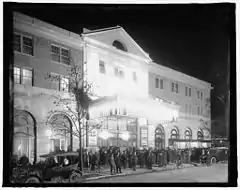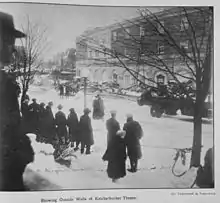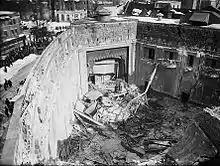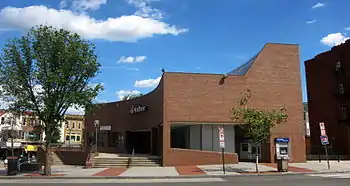Knickerbocker Theatre (Washington, D.C.)
The Knickerbocker Theatre was a Washington, D.C., United States, movie theater located at 18th Street and Columbia Road in the Adams Morgan neighborhood. It collapsed on January 28, 1922 under the weight of snow from a two-day blizzard that was later dubbed the Knickerbocker Storm. The theater was showing Get-Rich-Quick Wallingford at the time of the collapse, which killed 98 patrons and injured 133. The disaster ranks as one of the worst in Washington, D.C., history. Former Congressman Andrew Jackson Barchfeld and a number of prominent political and business leaders were among those killed in the theater. The theater's architect, Reginald Geare, and owner, Harry Crandall, later died by suicide, in 1927 and 1937, respectively.
| The Knickerbocker Theatre | |
|---|---|
 The Knickerbocker Theatre in October 1917 | |
 Location within Washington, D.C. | |
| General information | |
| Status | Destroyed |
| Type | Film theater |
| Location | 18th Street, and Columbia Road Northwest, Washington, D.C., United States |
| Coordinates | 38.92225°N 77.042806°W |
| Completed | 1917 |
| Destroyed | 1922 |
| Design and construction | |
| Architect | Reginald Geare |
Theater
The Knickerbocker Theatre was commissioned by Harry Crandall in 1917. Designed by architect Reginald Geare, it had a seating capacity of 1,700.[1] In addition to serving as a movie theater, it also served as a concert and lecture hall, with ballrooms, luxurious parlors and lounges.[2]
Collapse
On January 28, 1922, the Knickerbocker was showing the silent comedy Get-Rich-Quick Wallingford.[1] News reports estimated that between 300 and 1,000 people were in the theater that evening.[3] Two days before, a massive blizzard had begun and lasted 28 hours, resulting in significant accumulation of snow and ice throughout the Washington, DC area. It was the worst snowfall in the area since 1899, and much of the city was paralyzed by it.[3] The snow accumulation on the Knickerbocker's flat roof put significant strain on the structure, and on the evening of the 28th, it gave way.[1]

The collapse occurred suddenly just after 9:00 PM.[3] Witnesses reported that they had no hint of danger such as creaking or loud noises beforehand. With a loud noise, the roof of the theater collapsed onto the concrete balcony, and both in turn collapsed onto the orchestra seating section. In the moments after the collapse, a witness called a telephone operator, who spread the alarm to police, firefighters, and hospitals. She also phoned the city government, which ordered the immediate closure of all theaters in the city to prevent loss of life from any further collapses.[1] People nearby during the collapse rushed to help, although their efforts were disorganized until the arrival of more than 600 soldiers and Marines. It took time for authorities to gain control of the scene as relatives of people in the theater tried to gain entry. Authorities also experienced delays in getting fire engines and other equipment to the scene as the streets of the city were nearly impassable in places due to snow and vehicles that had become stuck during the blizzard. However, a fleet of ambulances from Walter Reed Army Medical Center and volunteer taxis were able to reach the scene and evacuate some of the injured to hospitals.[3]

Even with large numbers of police, firemen, and military personnel, by 2:30 the next day the rescuers had still not been able to remove debris from the balcony and reach those who had been seated in the orchestra. While they worked, a young boy crawled through the rubble and delivered water to the victims to keep them alive.[3] Neighboring houses and stores were used temporarily to give medical treatment to victims of the collapse, and a nearby Christian Science Church was used as a morgue. As a result of the collapse, 98 people died and 133 were injured.[1] Nearby residents, including the theater’s architect, Reginald Geare, helped pull bodies from the debris and feed the rescuers, also supplying them with hot drinks. Geare’s knowledge of the building’s design was invaluable in the rescue work.[2]
Many of those being pulled from the rubble were either dead or barely conscious. Contemporary accounts described severe crushing injuries that resulted in loss of limbs or forced amputations in order to extricate the victims.[3] Among the victims was former Pennsylvania congressman Andrew Jackson Barchfeld, and other politicians, members of the diplomatic corps, and businessmen.[4] Many media reports focused on less famous but more tragic figures, such as a violinist in the theater's orchestra who had been married five days previously and a honeymooning couple who were attending the movie that night. Another report mentioned a young boy who was brought to the temporary morgue to identify the bodies of both of his parents and his two sisters.[1]
Aftermath

A number of investigations were conducted into the causes of the collapse by the Washington, D.C., city government, both houses of Congress, the city coroner, and the courts.[5] Early witness accounts suggested that theater employees had discussed removing the snow from the roof, but had decided that it was unnecessary.[3]
The investigations concluded that the collapse was most likely the result of faulty design, blaming the use of arch girders rather than stone pillars to support the roof. However, a number of lawsuits that resulted from the collapse were unsuccessful, as courts were unable to determine who was liable.[1]
The year after the collapse, a new theater was built in the same location, dubbed the Ambassador Theater. This would in turn be torn down during a 1960s era urban renewal project, and the site is now the location of a Sun Trust bank. The building is shaped like a movie theater, to pay homage to the Knickerbocker Theater.[1][2]
Geare, whose career had been effectively ended by the collapse, died by suicide in 1927. Crandall died by suicide ten years later, leaving a note for reporters asking them not to be too hard on him.[1]
The storm which led to the collapse was later dubbed the Knickerbocker Storm.[1]
Book
In 2013, The Knickerbocker Snowstorm (Images of America), was released.[6]
References
- Fishbein, Gershon (January 22, 2009). "A Winter's Tale of Tragedy". The Washington Post. Retrieved February 9, 2010.
- Hansen, Stephen. "Knickerbocker Theatre: Death Trap of 1922". kaloramahistory.blogspot.com. Retrieved May 28, 2019.
- "Roof Suddenly Collapses". The New York Times. January 29, 1922. Retrieved February 9, 2010.
- "Many of Victims Were Well Known". The New York Times. January 30, 1922. Retrieved February 9, 2010.
- "Theater Wreck Inquiries Started" (PDF). The New York Times. January 31, 1922. Retrieved February 9, 2010.
- "The Knickerbocker Snowstorm: Inside insights on D.C.'s deadliest disaster". The Washington Post. January 28, 2013. Retrieved January 28, 2013.
Further reading
- Ambrose, Kevin (January 14, 2013). The Knickerbocker Snowstorm (Images of America). Arcadia Publishing. p. 128.
- Ambrose, Kevin (January 27, 2017). "Haunting faces, scenes and stories from the Knickerbocker Theatre roof crash 95 years ago". The Washington Post.
External links
| Wikimedia Commons has media related to Knickerbocker Theatre (Washington, D.C.). |